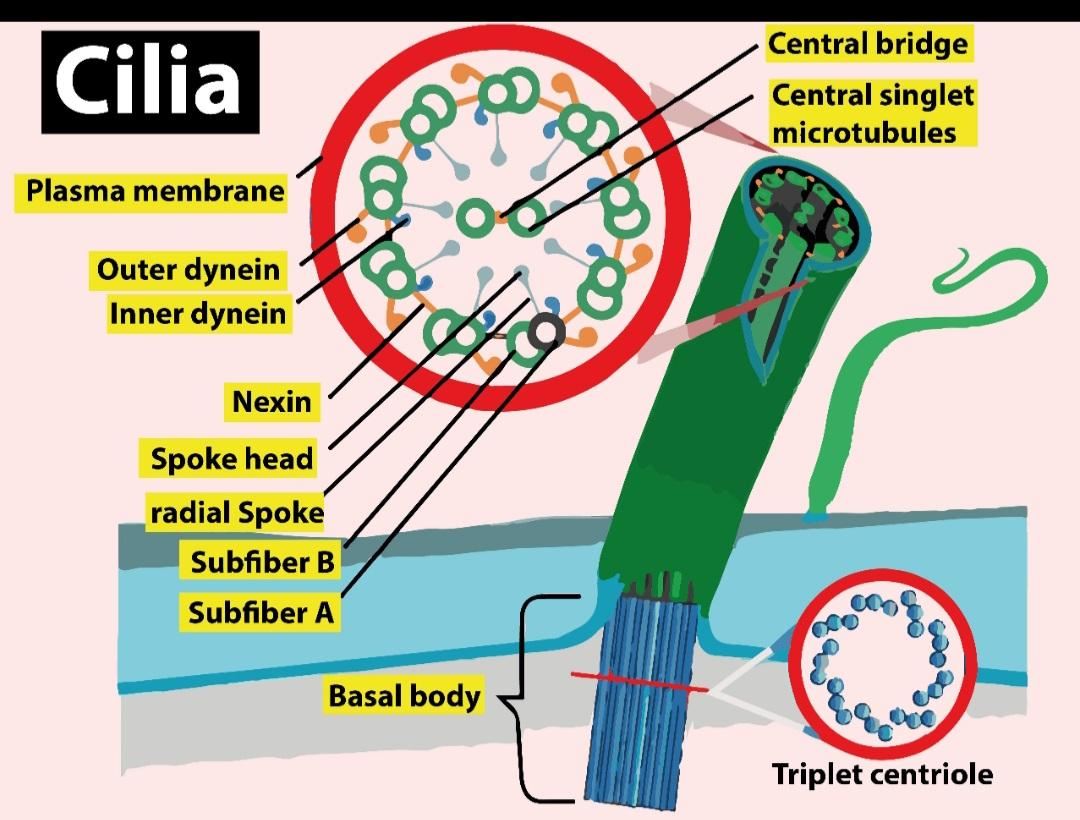
The cilia and flagella arise from
(A)Basal bodies
(B)Basal granules
(C)Blepharoplasts
(D)All of the above
Answer
484.8k+ views
1 likes
Hint: The cilia and flagella arise from one part and that one part has its three different names and all are starting with the same letter and the term is related to the base.
Complete answer:
The cilia and flagella arise from the basal body. Another name of the basal body is basal granule, kinetosome, and in older cytological literature it is also known as blepharoplast. The basal body is a protein structure found at the base of a eukaryotic cilium or flagellum. The basal body serves as a site for the growth of the axoneme microtubules.
Additional Information: Cilia and flagella are the projections that come out from the cell. They're made from microtubules and are covered by an extension of the cell wall. they're motile and designed either to move the cell itself or to move substances over or around the cell. The first purpose of cilia in mammalian cells is to move fluid, mucous, or cells over their surface. Cilia and flagella have an equivalent internal structure. The main difference is in their length. Cilia and flagella can move just because of the interactions of a set of microtubules inside. These sets of microtubules are called an "axoneme".Two of these microtubules join to form one doublet in the cilia or flagella This is shown in the middle panel. It was seen that one of the tubules is incomplete.
So, the correct answer is ‘All of the above’.
Note: Like the Cilia and Flagella, Centrioles are also made of microtubules. The basic difference is that they contain 9 sets of triplets and no doublet in the center. Centrioles come in pairs and each of them is organized at right angles to the other.

Complete answer:
The cilia and flagella arise from the basal body. Another name of the basal body is basal granule, kinetosome, and in older cytological literature it is also known as blepharoplast. The basal body is a protein structure found at the base of a eukaryotic cilium or flagellum. The basal body serves as a site for the growth of the axoneme microtubules.
Additional Information: Cilia and flagella are the projections that come out from the cell. They're made from microtubules and are covered by an extension of the cell wall. they're motile and designed either to move the cell itself or to move substances over or around the cell. The first purpose of cilia in mammalian cells is to move fluid, mucous, or cells over their surface. Cilia and flagella have an equivalent internal structure. The main difference is in their length. Cilia and flagella can move just because of the interactions of a set of microtubules inside. These sets of microtubules are called an "axoneme".Two of these microtubules join to form one doublet in the cilia or flagella This is shown in the middle panel. It was seen that one of the tubules is incomplete.
So, the correct answer is ‘All of the above’.
Note: Like the Cilia and Flagella, Centrioles are also made of microtubules. The basic difference is that they contain 9 sets of triplets and no doublet in the center. Centrioles come in pairs and each of them is organized at right angles to the other.

Latest Vedantu courses for you
Grade 11 Science PCM | CBSE | SCHOOL | English
CBSE (2025-26)
School Full course for CBSE students
₹41,848 per year
Recently Updated Pages
Express the following as a fraction and simplify a class 7 maths CBSE

The length and width of a rectangle are in ratio of class 7 maths CBSE

The ratio of the income to the expenditure of a family class 7 maths CBSE

How do you write 025 million in scientific notatio class 7 maths CBSE

How do you convert 295 meters per second to kilometers class 7 maths CBSE

Write the following in Roman numerals 25819 class 7 maths CBSE

Trending doubts
State and prove Bernoullis theorem class 11 physics CBSE

What are Quantum numbers Explain the quantum number class 11 chemistry CBSE

Write the differences between monocot plants and dicot class 11 biology CBSE

1 ton equals to A 100 kg B 1000 kg C 10 kg D 10000 class 11 physics CBSE

State the laws of reflection of light

In northern hemisphere 21st March is called as A Vernal class 11 social science CBSE




